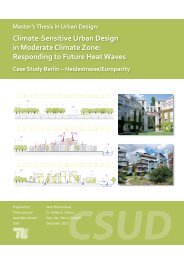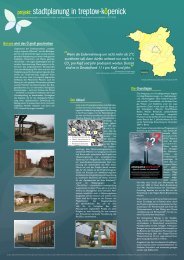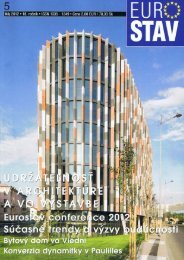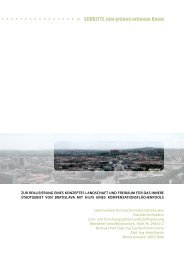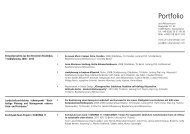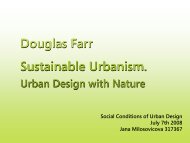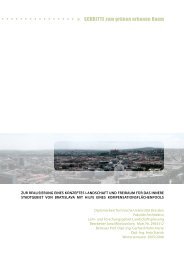Bausteine - Referate - Jana Milosovicova - Urban Design English
Bausteine - Referate - Jana Milosovicova - Urban Design English
Bausteine - Referate - Jana Milosovicova - Urban Design English
Erfolgreiche ePaper selbst erstellen
Machen Sie aus Ihren PDF Publikationen ein blätterbares Flipbook mit unserer einzigartigen Google optimierten e-Paper Software.
Sustainable neighborhood rating systems: An international comparison<br />
Die Bewertungsmatrix<br />
Assessment Matrix takes a simpler approach<br />
to habitat, with three areas graded: protected<br />
areas, habitat and flora & fauna. The best scores<br />
are given when there is a positive influence on<br />
these areas, with the score declining if there is<br />
no influence and then by a range of potential<br />
negative influences.<br />
Site Disturbance<br />
Site disturbance is addressed only by LEED-ND.<br />
One credit includes not developing on steep<br />
slopes over 15 percent in undeveloped areas or<br />
limiting development on slopes between 15 to<br />
40 percent in previously developed locations; in<br />
either case slopes over 40 percent cannot be<br />
used. During the construction process, there is<br />
a prerequisite for implementing an Erosion and<br />
Sedimentation Control Plan and credits for minimizing<br />
site disturbance either of total land or<br />
of areas near construction.<br />
5. Social Issues<br />
The Social Issues category, only addressed by<br />
LEED-ND, goes beyond the traditional focus<br />
on the environmental aspect of sustainable development<br />
and broadens the scope to social<br />
and equity concerns as well. Most prominent<br />
are the affordable housing credits, for including<br />
for-rent affordable units and another for<br />
including for-sale affordable units. The credits<br />
follow common housing goals: 10 to 30 percent<br />
affordable units, rental units affordable to<br />
people below the federally defined Area Median<br />
Income and for-sale units affordable at<br />
earning the Area Median Income. The universal<br />
accessibility credit requires at least 20 percent<br />
of all residential units and all common spaces be<br />
handicapped accessible. Finally, a credit for community<br />
outreach is intended to foster greater<br />
dialogue between the developer, the city and<br />
the neighborhood residents in the creation of a<br />
new development.<br />
6. Resource Efficiency<br />
The Resource Efficiency category addresses<br />
primarily common green building criteria, from<br />
reduced water and energy use to recycled materials.<br />
LEED-ND evaluates a range of these<br />
construction issues, offering credits for greening<br />
both buildings (overlapping the LEED building<br />
rating systems) and infrastructure. Due to the<br />
focus of the Assessment Matrix on location<br />
evaluation, only a minority of the issues that arise<br />
in the construction process are considered.<br />
Green & Efficient Buildings<br />
LEED-ND has several credits that mirror the<br />
LEED for buildings criteria, including LEED certified<br />
buildings in a project, with points starting<br />
at 20 percent LEED certified buildings to 40<br />
percent or more. Credits are also given in<br />
LEED-ND for core elements of the LEED for<br />
building systems, including building energy efficiency<br />
and reduced water use. At the site level,<br />
a LEED-ND credit is given for a reduction of at<br />
least 15 percent site level energy consumption<br />
from street lights, water and wastewater pumps<br />
and water and wastewater treatment systems<br />
as well as for using LED traffic light technology.<br />
Finally there are two credits for building reuse,<br />
the first is for reusing at least one buildings and<br />
the second for reusing a historic building and<br />
rehabilitating it to federal standards for rehabilitation.<br />
Microclimate<br />
LEED-ND considers microclimate in terms of<br />
heat island effect, with a credit for installing either<br />
roofs with a high solar reflective index or<br />
green roofs. This credit can also be achieved<br />
by either shading half of the impervious site<br />
landscape or using paving that has a high solar<br />
reflective index or an open grid. In addition,<br />
LEED-ND offers a credit for solar orientation:<br />
either orienting blocks north-south or buildings<br />
east-west. In the Assessment Matrix, microclimate<br />
is focused on fresh air, providing the best<br />
108



